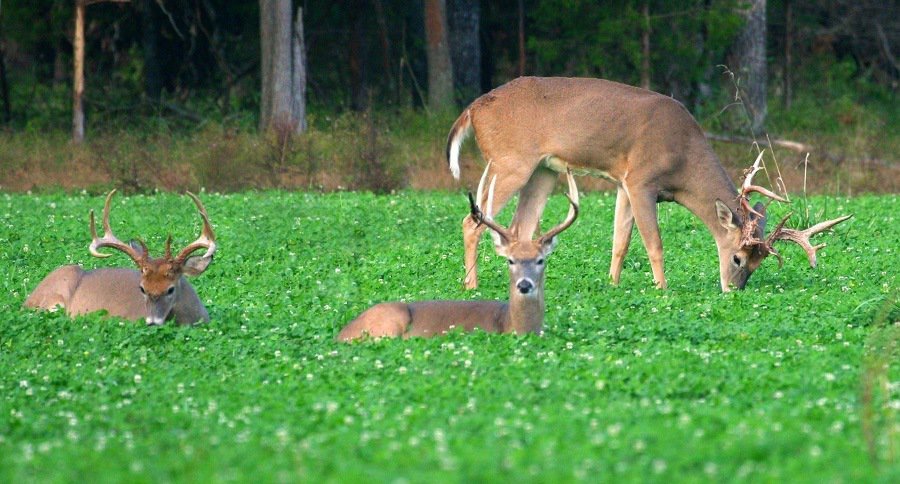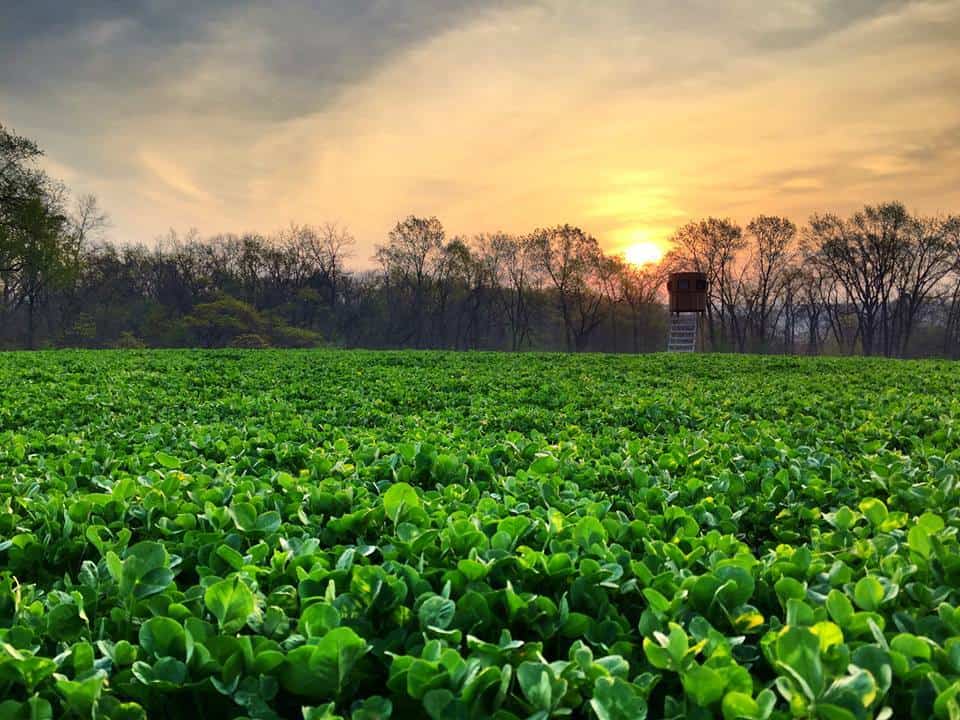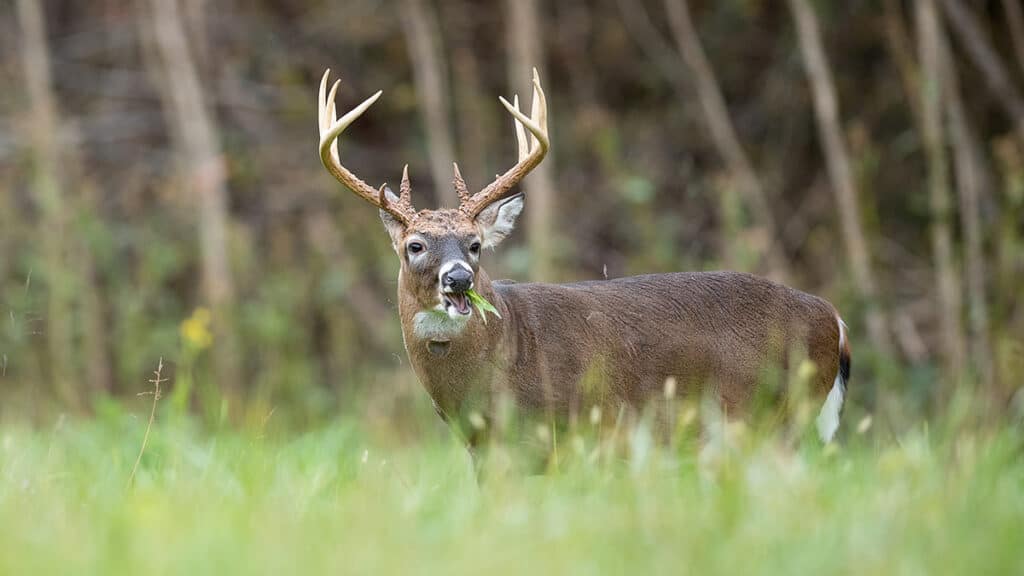There isn’t much that hunters won’t do to bag a buck big enough to hang on the wall. Some will wear doe urine like it’s cologne or spend weeks sitting in a tree stand in freezing temperatures. Something else a motivated hunter can do to increase their odds is plant a food plot before the season. It’s undeniable that they can help attract more deer, and even improve the overall health of the local deer population, but are they legal across the country?
Food plots are legal in most states, but not all. Eleven states including Alaska, Arizona, Colorado, Florida, Idaho, Massachusetts, Montana, New Hampshire, Rhode Island, Washington, and West Virginia either forbid food plots or place stricter regulations on them.
Each state has a different definition of what it means to feed or bait deer. So when food plots are created with the intent of feeding deer to harvest them, their legality depends on how that state defines baiting, and whether or not they have any other restrictions in place, likely due to CWD or other diseases.
Today, we’ll take a closer look at exactly what a food plot is and some of the lesser known factors that can determine whether or not they are legal in your state. I’ll show their similarities and differences from baiting, and the arguments for and against them. Although we will start with a quick section on which states allow and don’t allow food plots.
State By State Regulations Regarding Food Plots
There are seven states that either strictly ban food plots, or do not totally cover them in their regulations, leading to a sort of a gray area. Four more states allow them, but with added regulations. To put all of that information in one place, I made a table of all 50 states and their rulings on food plots, along with a link to their DNR section about it. You can check it out here and see what your target state has to say about food plots.
Check out the table here: Food Plot Legality By State
Since the definition of a food plot varies from state to state, some states don’t explicitly state their stance and answer the question “are food plots legal?”. Hunting food plots can be considered baiting in certain situations, so I compiled a list of each state’s relevant natural resource agency. If some of the legal jargon is tough to understand, then give your local Department Of Natural Resources a call so you can be 100% sure that you are always in the right.
To save some time, the states that expressly do not allow food plots are Arizona, Colorado, Idaho, Massachusetts, New Hampshire, Rhode Island, and Montana. A few other states have restrictions on what can be planted and when, so check out the full table here to see your state.

Always Check Your Local Hunting Regulations
Before we dive into the legality of food plots, I need to stress the importance of checking your local deer hunting laws. Some states, like Wisconsin, only allow feeding or baiting in certain counties. None of us have the time (or attention span) to list county-by-county whitetail hunting regulations for the entire country. If you have even the slightest doubt about the legality in your area, be sure to check with your local wildlife agency.
You can look it up in the hunting regulations, or contact a local game officer by phone or by walking into a local DNR or Fish and Game Office. The people in these offices are usually really easy to work with and can give you lots of good input for your plans or projects.
The Department of Fish and Game or DNR has the management and conservation of wildlife in mind. If you come to them with the same attitude and goals, they will want to help you.
Baiting Vs. Food Plots | What’s The Difference?
The main reason that the answer to, “Are food plots legal?” isn’t a simple yes, stems from the subjective nature of what a food plot is and how (or if) it differs from baiting. It is important to know the difference between baiting deer and using a food plot to attract them. Some hunters will argue that they are one and the same. That definitely isn’t the only take on the subject.
As far as legality goes, every state will have its own definition of both food plots and baiting. This means that some states will permit both, some won’t allow either, and some may let hunters use a food plot so long as it doesn’t fall into that state’s definition of baiting.
If you are unsure of the difference, here are the broad strokes to give you an idea based on all 50 states’ laws. Most states consider baiting as a specific area where a food product or commercial deer attractant is deliberately placed with the purpose of luring in deer. A food plot is a larger area that contains a standing natural food source that deer are known to eat. Think of baiting as a pile of corn placed in the middle of a field and a food plot as a field of standing or harvested corn.
The important takeaway here is to know that in the eyes of the law, there is sometimes a difference between the two, but not always. Baiting is also legal in many states, and plenty of hunters do it every year. I wrote an entire article about attracting deer and I included short term solutions like baiting, and longer term solutions like habitat management and food plots. Give it a read by clicking here.

When Does A Food Plot Become Illegal?
As we stated earlier, there is nothing illegal about a food plot by itself. Every agricultural area where corn, sunflowers, or other favorite whitetail foods are farmed is technically a food plot. Whether or not a plot is considered illegal usually hinges on the reason it was planted in the first place and how the food is dispersed. If this sounds confusing, that’s because it is.
Some, but not all, states have a distinction between baiting and food plots. For example, in Alabama it is legal to have food plots smaller than a certain size, but “Hunting with the aid of bait is prohibited on public lands (including WMA, SOA, USFS, TVA, Corp. of Engineers and public and private land within the CWD CMZ)” is illegal.
Colorado has a different view on the subject, stating that: “Hunt[ing] big game over bait, whether or not the person hunting personally placed the bait [is illegal]. Bait means to put, expose, distribute or scatter salt, minerals, grain, animal parts or other food as an attraction for big game. Salt or mineral blocks used for normal agricultural purposes are not considered bait.”
And Wisconsin states that: “Hunting with the aid of material deposited by natural vegetation, material found solely as a result of normal agricultural or gardening practices, or with the aid of crops planted and left standing as wildlife food plots is legal. It is illegal to establish or maintain food plots/plantings on DNR-owned or managed lands.”
You are probably starting to notice that there is a lack of a pattern going on here, and you wouldn’t be wrong. Most of these laws were created with wildlife and game feeders in mind, but the ambiguous wording in some of the laws may technically make hunting a food plot illegal.
Did You Know I Had a Newsletter?! 📬
I do! I send out a weekly email that talks all about deer hunting and is a bit more personal than a regular article. If you sign up right now, I will even send you the first chapter of my Ebook “The Hunters Guide to Scent Control” for free! What is there to lose? 🙂
What Are Some Reasons That Food Plots Are Considered Bad?
Perhaps the most prevalent reason that food plots get a bad rap is their association with baiting. Although baiting is a tried and true practice that has been around for ages, some view it as a lesser form of hunting. Fair chase is questioned and even the practice of using any form of attractant can be attacked as unethical.
The risk of disease is also a huge factor that should be realized and understood. Many diseases are transmitted because of high concentrations of deer near a food source where one unhealthy animal will start to feed. This can cause fast growth of infection in a herd.
Fair Chase
Since some hunters equate food plots and baiting deer as the same practice, they can be frowned upon in certain situations. The thrill of the hunt is a major part of what makes hunting such a memorable experience, and some hunters view using any sort of food, bait, or attractant as cheating.
By using a food plot as an aid, some would argue that it takes one of the most important parts of the experience out of the equation. To come back to the real meaning of fair chase as related to food plots, fair chase simply states that the free range wild animal is not being restricted to a particular action that gives the hunter an unfair advantage.
Again this statement could be viewed as subjective. Many people will interpret it differently when they think about food plots.
Risk Of Disease
This is probably the greatest issue that could be brought against food plots. Chronic Wasting Disease is a nasty problem within some deer populations. There is a fair amount of research that points to baiting and feeding deer or food plots as a way of spreading this disease. Yes, baiting deer can have this effect because CWD spreads through contact with things like saliva, urine, and feces, and it encourages denser populations of deer to feed in the same area off of the ground.
That being said, effective food plots generally feature an even distribution of plants that haven’t necessarily been lying on the ground. It wouldn’t be entirely fair to compare these two practices because they aren’t the exact same thing.
Baiting provides food in one concentrated location that has been harvested and is easily consumed. A food plot, on the other hand, has feed in its natural state spread out and distributed throughout a larger area comparatively.

Splitting Hairs | Food Plot Legality
Since the laws can be unclear on paper at times, it is good to know about some of the distinctions that states use when they don’t have an explicit yes or no stance on the use of food plots. Factors like state owned vs. private land, specific times throughout the year, and bow season vs. rifle season can all affect whether or not a food plot is legal in your state.
Assuming that you live in a state that is ok with using a plot of land to attract deer, you still have to keep in mind that there are different rules regarding public and private land. You may also assume that it is alright to do as you see fit on private property, but once again, this isn’t always true.
Conversely, some states like South Dakota view food plots as a beneficial tool for wildlife management, so they offer programs to reimburse landowners to lease their property to the state as public walk-in grounds for hunting.
Some states fall into what seems like a legal gray area because feeding deer is allowed, but only during certain times of the year. This may call the legality of your food plot into question depending on how long it took to grow your crops and when it was harvested.
Why You Would Want a Food Plot
Although there is a fair amount of debate and uncertainty behind food plots, they can actually be advantageous for a couple of reasons. If properly managed, they can attract more deer in the area and have a beneficial effect on herd health and nutrition.
In addition to water and safe travel corridors, two things that will help attract and hold more deer in a particular area are food and shelter. A properly placed food plot can actually satisfy both of these at the same time. Providing ample cover crops where they can eat and bed down in the same general area is a win-win, but this isn’t always possible due to property size. Supplying a food plot next to an area where the deer feel secure is another way to meet the need on a smaller plot of land.
An effective food plot not only brings the deer into an area it helps keep populations healthy. You can think of a food plot as an extra piece of habitat that you created for whitetail and or mule deer to thrive in. This is all assuming that the area wouldn’t be overhunted. The fact is that an underutilized field would do very little to contribute to a deer population when compared to an area with a nutritious food source tailored to a deer’s needs.
There is an argument to be made to leave the fields be and let them grow what is natural in the area. This is often associated with the Conservation Reserve Program, and short-handed to CRP. Fields of tall natural grasses can often be beneficial and provide cover for deer, not to mention a lot of resources for smaller wildlife, but they don’t provide nearly as much nutrition for our whitetails.
Herd health is a very important topic. Ask any wildlife biologist or natural resources officer, and they will tell you the same. One of the key components of a healthy herd is a food source that provides the right nutrients and lasts for a better part of the year. Outside of regions where agriculture is big, food can become scarce during particular times of the year. Providing a food source that can feed the herd during these times will help ensure the overall health of the herd.
Should You Plant a Food Plot?
Whitetail hunting rules and regulations can be confusing for even the most seasoned hunters. That said, you as the hunter will always be the one responsible for abiding by the rules. The last thing you want to do is spend the time and money it takes to make a nice food plot, sit in your blind on opening day or during the rut, and then get a visit from ol green jeans on your way out.
While food plots are legal and even encouraged in certain parts of the country, they might not be ok to utilize in certain regions based on a handful of different factors. The best and only surefire way to guarantee that you are abiding by the rules and regulations is to speak to the people who enforce them. Your local wildlife/natural resources agency is the best resource out there when it comes to ensuring that your food plot is legal.
Sister Post | 20 Cheap Ways to Attract Whitetail Deer
A sister post is another post that I have written that follows along with the same topic as the one you just read. After reading this article, you will probably like this next one even more! Here is a little teaser…
Everything costs more these days, and that is definitely the case with hunting gear. If you are not seeing as many deer on your property as you would like, throwing out some kind of bait or attractant is the way to go…Keep Reading
Using Baits & Attractants During The Season
Baiting deer is extremely popular throughout the United States. However, it is illegal in a couple dozen states…Keep Reading
Cheaply Attracting Deer With Habitat Management
Feeding deer year-round promotes habitual use of desired areas, say, near your stands. It’s no different than feeding during the season…Keep Reading
Thank you for reading my article! I hope you enjoyed it, and if you have any questions or feedback, please send me an email at [email protected]. If you want to learn more about me or Omega Outdoors, visit my About Page. Otherwise, I hope you have a great day, and check out some of my other articles while you’re here!

